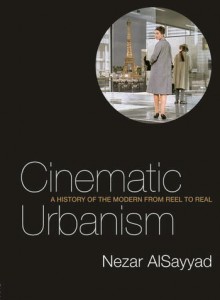On a related topic:
Film and Urban Space (2014)
Critical Possibilities
by Geraldine Pratt and Rose Marie San Juan
Subject: Sociology
Global Cinematic Cities (2016)
New Landscapes of Film and Media
Dir. Johan Andersson and Lawrence Webb
Subject: Sociology
From Empire to the World (2015)
Migrant London and Paris in the Cinema
by Malini Guha
Subject: Sociology
Urban Cinematics (2011)
Understanding Urban Phenomena through the Moving Image
Dir. François Penz and Andong Lu
Subject: Sociology
Cities in Transition (2008)
The Moving Image and the Modern Metropolis
Dir. Andrew Webber and Emma Wilson
Subject: Sociology
Motion Picture Exhibition in Baltimore (2013)
An Illustrated History and Directory of Theaters, 1895–2004
Subject: Economics
Cinematic Urbanism
A History of the Modern from Reel to Real


Average rating: ![]()
| 0 | rating | |
| 0 | rating | |
| 0 | rating | |
| 0 | rating |
Your rating: -
Book Presentation:
The city and the cinema have become inextricably intertwined over the last century, with the identities of places becoming bound up in their cinematic portrayals. We have seen the landmarks of New York, London and Tokyo turn into iconic symbols of wealth, power, status, style and culture, and for the majority of people the images and sounds of movies form the only experience they will ever have of distant cities.
Cinematic Urbanism presents an urban history of modernity and postmodernity through the lens of cinema. AlSayyad traces the dissolution of the boundary between real and reel through time and space via a series of films that represent different modernities. They include:
Cinema Paradiso
It's a Wonderful Life
Metropolis
Brazil
Blade Runner
Annie Hall
Taxi Driver
Do the Right Thing
My Beautiful Laundrette
The Truman Show.
Alsayyad argues that our understanding of the city cannot be viewed independently of cinematic experience. Films do not only capture the depiction of a society; they influence the way we construct images of the world and, as a result, how we operate within it. We are beginning to blur the distinction between what is real in the everyday, and how we imagine the everyday. Cinematic Urbanism explores this dynamic, bringing together insights from urban and film studies to illuminate current architectural debate.
.
About the Author:
Nezar AlSayyad is Professor of Architecture, Planning and Urban History at the University of California at Berkeley. He is the Associate Dean for International Programs at the College of Environmental Design, and Chair of the Center for Middle Eastern Studies at Berkeley. Additionally, he is the Director of the International Association for the Study of Traditional Environments and principal editor of its journal, Traditional Dwellings and Settlements Review.
See the publisher website: Routledge
> From the same author: